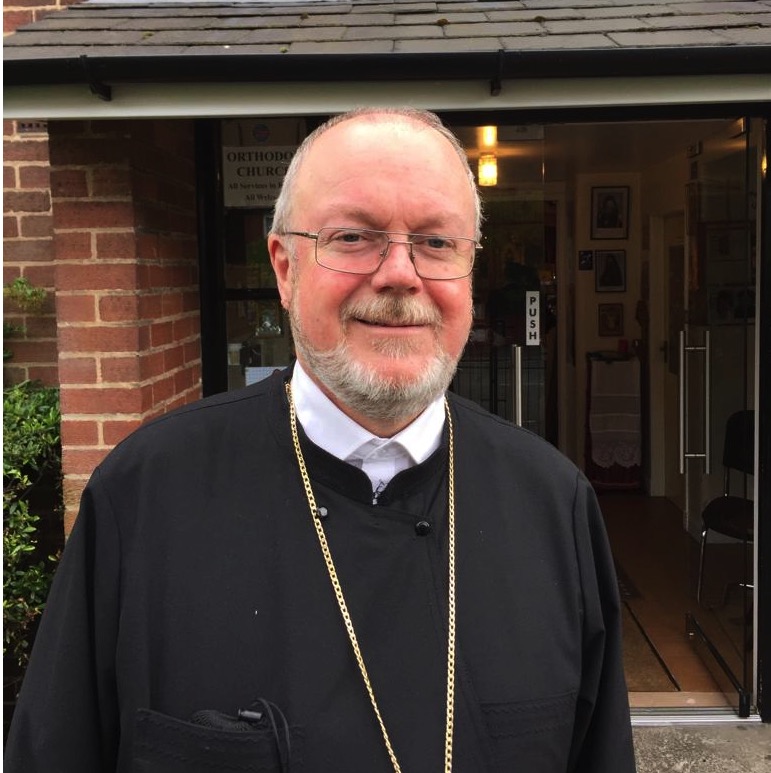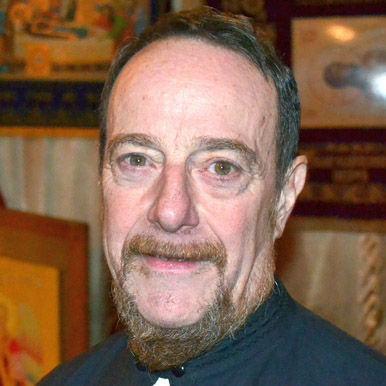In the name of the Father and of the Son and of the Holy Spirit. God is one. Amen.
The Gospel reading today from the 8th chapter of the Gospel of St Luke is about two women who are healed—an older woman in considerable pain and a younger woman who has died. The older woman is healed when she touches the loose threads, the tzitzit in Hebrew, at the end of the prayer shawl, the tallit in Hebrew, that Jesus Christ is wearing. Children, this is an example of the prayer shawl that Jesus Christ was wearing. Of course, this is not the actual prayer shawl from first century Palestine, but this prayer shawl is still often worn today by Orthodox Jewish men. The custom is that the prayer shawl is worn outside of other clothes, with the edges, the loose threads, quite visible. Now, in this Gospel reading, as Jesus Christ passed by, this sick woman boldly reached out and touched these loose threads and was immediately healed from an illness that had been going on for twelve years.
In this Gospel, Jesus Christ immediately said, “‘Who touched me?’ And when everyone denied it, Peter said, ‘Master, the crowds press in and are jostling you [that is, are pushing roughly against you].’ But Jesus said, ‘Someone touched me; for I was aware of power having gone forth from me.’ And the woman seeing that she was not hidden from view, came trembling and fell down before Him, and declared before all the people for what reason she had touched Him, and how she had been instantly cured. And He said to her, ‘Daughter, your faith has healed you; go in peace.’” St Ambrose, the great 4th century preacher and teacher, offers a remarkable interpretation of this Gospel.
St Ambrose explains that the sick woman ran to Christ and “saw Him thronged [that is, surrounded by a large crowd].” St Ambrose preached, and I quote: “Those who throng do not believe [because] Christ is touched by faith; Christ is seen by faith. He is not touched by the body. He is not [seen] by the eyes.” St Ambrose continued: “This [event] is a clear indication that Wisdom is not enclosed … within the boundaries of the body…. We see that in comparison to [Christ], we only touch the fringe and cannot reach the upper part of His garment, [but] whosoever has touched the fringe … does not escape the notice [of Christ]. For God does not need eyes to order to see, … but possesses within Himself the knowledge of all things. Blessed [are those] who have touched the uttermost [that is, the greatest possible amount] of the Word [of God], for who can comprehend the whole?”
In Jewish tradition, these fringes represent the attributes—the characteristics—of God. So, what this woman is doing is reaching out to touch the Lord. And, as Jesus Christ tells her: “‘Daughter, your faith has healed you; go in peace.’” That’s a model for each of us today: we can reach out in our lives and touch the presence of Christ. This is not a school examination in which we receive a grade. Whatever our age, we each touch as much of Christ as we can. That faith to reach out and touch Christ brings us a deep inner peace in which Christ lifts us up and protects and guides us in the midst of any troubles we are experiencing.
The second healing in this Gospel is of a little girl aged 12. Her father, Jairus, a leader in the Jewish synagogue, has come to Jesus Christ because he knows that his daughter is dying. Jesus sets out for their home. However, someone from his home town tells him, and I quote: “‘Your daughter has died; do not trouble the teacher further.’ But hearing this, Jesus answered him, ‘Do not be afraid; only have faith and she will be saved.’ And on coming into the house, [Jesus] permitted no one to enter with Him, except Peter and John and James and the girl’s father and mother.” So, what did Christ do? He went into the house and He touched the dead little girl. He took hold of her hand and said, “Little girl, arise;” and “she at once arose, and He instructed that she be given something to eat.”
With the earlier healing, the woman reached out to touch Christ. With this healing of the little girl, it is Christ who reaches out to hold her hand. St Ambrose preached: “I wish that [same] righteousness [would] hold my acts and my hands. I want the Word of God to hold me, bring me [closer], turn away the spirit of error, replace it with that of salvation, and order that I be given something to eat! The Word of God is the Bread of heaven.” St Ambrose then cites the words of Wisdom from Proverbs, chapter 9, verse 5: “Come, eat of my food and drink of the wine that I have mixed.” St Ambrose then explains that in this Gospel passage about the two healings, Christ Himself is Divine Wisdom, the Wisdom, and I quote, “that filled the holy altar with the nourishment of the Divine Body and Blood.” That is what we are now offered—the Divine Body and Blood—which reaches out to touch us with the presence of Christ, just as it touched these two women in this Gospel passage.
So be it, as we ascribe as is justly due, all might, majesty, dominion, power and praise to God, Father, Son and Holy Spirit, always now and ever and unto the ages of ages. Amen.

 Archpriest Gregory Hallam
Archpriest Gregory Hallam
 Fr. Emmanuel Kahn
Fr. Emmanuel Kahn